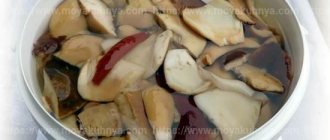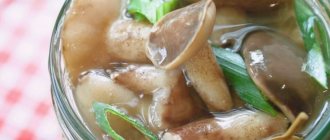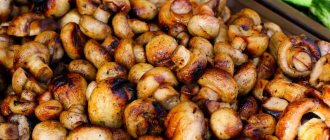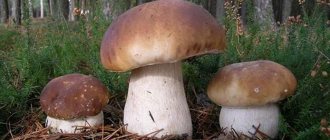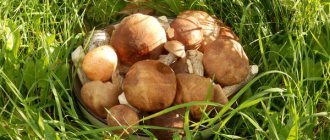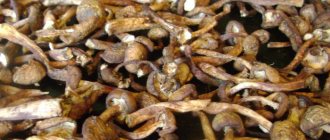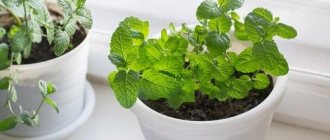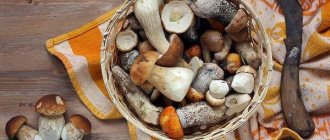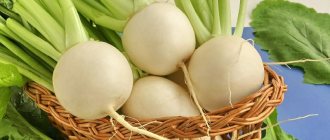What's normal?
First, let's turn to traditional Russian recipes for pickling mushrooms and see how it's done correctly . After all, if you compare your actions with the ideal, mistakes will immediately become visible!
There are two types of mushroom pickling: cold and hot .
1. Cold salting. The mushrooms are cleaned of debris, filled with cold, unboiled water and left for 2-3 days in a cool place (16-18 degrees Celsius). The main condition: the water needs to be changed 2 times a day so that the mushrooms do not sour. The soaked mushrooms are washed and allowed to dry. Sprinkle the bottom of a clean dish with coarse salt, and place mushrooms on it, caps down. Width of one mushroom layer: 5-7 cm. Amount of salt: 30-50 g (1-2 tablespoons) per 1 kg of mushrooms (which approximately corresponds to 1 liter). The layers are laid one by one, sprinkling each with salt and placing currant leaves and dill umbrellas between them, to the very top. The last layer is covered with currant leaves and a clean, thick cloth. All this is pressed down with a wooden circle and oppression (heavy stone). After 5-6 days, you need to check whether all the mushrooms are covered with brine. And after another month and a half they can be eaten.
Important! During pickling, it is important to periodically check whether the mushrooms are covered with brine or not. If it is not enough, add boiled cool water to the container. When salting using a cold method, at first it is recommended to wash the fabric daily.
2. Hot salting. Clean mushrooms are carefully transferred to an enamel pan or basin, filled with water and set to cook. There is no need to stir them until they boil. And after boiling, stir the mushrooms from time to time and skim off the foam. Cook most mushrooms before salting for 15-20 minutes, honey mushrooms and chanterelles for 25-30 minutes. After this time, they are thrown into a colander. Once the water has drained, sprinkle the boiled mushrooms with salt and place them in the same way as the cold method.
Important! If the weather is hot and there is no place with a suitable temperature (10-12 degrees Celsius), you need to add more salt - 50 g per 1 liter.
Tip 2: How to eat mushrooms
How to select and store mushrooms
Mushrooms are distinguished by their low calorie content and at the same time the presence of a certain amount of valuable substances used in pharmaceuticals for the preparation of medicines. Therefore, if you eat mushrooms correctly, you can not only amuse your stomach, but also improve your health.
When choosing mushrooms, you should check the integrity of their caps and the absence of wormholes. When purchasing, it is important to ensure that it is not wet. This indicates that the mushroom is not fresh. Mushrooms should always be stored in the refrigerator, but under no circumstances in plastic bags. You can use the freezer for these purposes, then you first need to heat them in oil in a frying pan. And keep in the freezer for no more than a month.
How to cook a mushroom without any trouble
Mushrooms are not a light food, so it is correct if they act not as a main course, but as an appetizer, a delicacy. They can be eaten only after high-quality processing that removes from them components harmful to human health.
If the mushroom is going to be fried, then before doing this it should be boiled in a large amount of water for at least 15 minutes. After pickling, mushrooms can be served no earlier than a month and a half later.
Who can eat mushrooms and who can't?
Due to the fact that mushrooms are poorly digestible, they should not be eaten by people with stomach problems (gastritis, enteritis, ulcers), liver and kidneys. In patients with gout, they can cause an exacerbation of the disease.
The consumption of mushrooms is contraindicated for pregnant women and children under 12 years of age, since the latter lack the enzymes necessary for digestion.
Even if your health is fine, you should not eat more than 200 grams of dishes prepared from fresh mushrooms at one time. For salted and dried - no more than 100 and 20 grams, respectively. If you want to get health benefits from mushrooms, remember that they retain their medicinal properties only with two processing methods: fresh pickling in barrels and drying.
How to cook a mushroom without any trouble
Much depends on storage conditions
It is correct to store salted mushrooms in a cool, well-ventilated place, where the mark on the thermometer does not rise above +1, +3 degrees. If the temperature is lower, the mushrooms will freeze and lose their taste, and in excessive heat (above +6 degrees) they will sour.
After finishing the salting, it is better to put the mushrooms in jars, put the spices from the bucket on top and cover with lids. The jars are stored well in the refrigerator at a temperature of +5, +8 degrees.
If mushrooms are pickled directly in jars, you should not cover them with lids, only with a cloth. To allow air to enter, densely packed mushrooms are pierced with a stick to the very bottom, like sauerkraut. With access to air, the development of botulism is impossible, which is very important when preparing products that have come into contact with the ground.
A wooden barrel or enamel bowl is more suitable for pickling mushrooms. You also need a dark, cool place where the mushrooms will stand throughout the pickling period.
In hot weather, if there is no cellar and there is no cool place in the house, the hot salting method is most relevant. When cold salting, there is a high probability that the mushrooms will sour even at the stage of soaking in cold water.
That time, when our mushrooms turned sour, we did hot pickling .
Selection and preparation of mushrooms for pickling
Almost all edible and some conditionally edible mushrooms are suitable for pickling. The following types are popular today:
- Champignon;
- White mushrooms;
- boletus;
- Russula;
- boletus;
- boletus;
- chanterelles;
- saffron milk caps.
Young and strong fruits are chosen for harvesting for the winter.
Damaged areas are cut off, and it is advisable to throw away wormy specimens. The crop is cleared of debris and washed thoroughly. If the mushrooms are small, then they are used whole, and large ones are cut into several parts. When preparing some mushrooms, for example, umbrellas, oyster mushrooms, the stems are cut off from the caps. Preliminary preparation of butter includes removing the top layer of skin. Before cooking, the milkweed is soaked in water from several hours to three days, which allows you to get rid of the bitterness of the milky juice.
All varieties must undergo heat treatment, which is an excellent prevention of poisoning and prolongs the suitability of the dish. Chanterelles, honey mushrooms and boletus caps, the flesh of which is dense, are boiled for 20-30 minutes. Kozlyaki, boletus and boletus are boiled for no more than 15-20, after adding salt to the water.
How our mushrooms became covered with mold
We cooked the mushrooms (volnushki and black milk mushrooms), washed them, and left them to drain. Then they placed the mushrooms in an enamel bucket in layers, sprinkling with salt at the rate of 1 tablespoon per 1 liter of boiled mushrooms. This is the dosage of our woman Tanya. I can assume that in our case more salt could have been added (as recommended in the source above). The autumn turned out to be warm and sometimes it was too warm on the balcony, and in such conditions the authors of the articles advise increasing the proportions of salt.
They covered the whole thing with a cloth, put a clean plate upside down and pressed it with a stone.
After a few days, the mushrooms fermented and became moldy, and they smelled unpleasant. My husband and I decided to boil them again. The entire salting procedure was done from the very beginning (it was also recommended in the literature), but nothing helped. Soon the mushrooms turned sour again. So they threw it away because they were afraid to eat it - mushroom poisoning is one of the worst. Why risk your health?
Since then, we have not taken corned beef from the forest and have not salted mushrooms.
Is it possible to eat pickled milk mushrooms if they are moldy?
Many housewives ask: if pickled milk mushrooms are moldy, can they be eaten? There is no definite answer, but if mold appears in the mushrooms 12-36 after pickling, they can be saved. However, this will only be possible if the jars were not sealed with metal lids.
- Mushrooms are washed in acidified water, adding vinegar or citric acid.
- Boil 2 times for 15 minutes with the addition of a small amount of salt.
- Wash again and pour in the newly prepared marinade with plenty of salt and spices.
Interesting: Frozen chanterelles: beneficial properties and contraindications
If mold is noticed in other layers of milk mushrooms, then throw away such an appetizer without hesitation. Especially if a layer of black mold film has formed under the metal covers. Spores from it can rise into the air and enter a person’s lungs, which is very dangerous to health and can lead to dire consequences.
Mold on salted mushrooms: What to do?
In country literature they write that the appearance of mold on the surface of salted mushrooms is normal. What to do in this case?
- The mold needs to be removed.
- Rinse the cloth that covered the mushrooms well in hot salted water. Do the same with a wooden circle and oppression.
- The walls of the dishes where there was mold should be wiped dry with a clean damp cloth.
It is believed that the appearance of mold in an acidic environment is natural, and it is harmless to humans. The fact is that during aerobic fermentation (fermentation and pickling of mushrooms as well) favorable conditions are created for the proliferation of yeast and mold.
Such mold does not harm humans, but it must be removed so as not to spoil the entire dish.
And if the mushrooms have soured, you can boil them again, but this does not always help - as in our case, for example.
Why do salted mushrooms spoil and should they ferment?
Some people mistakenly assume that fermentation inside pickle jars is normal. However, in fact, if the twist begins to ferment, this indicates negative processes that should not occur within it.
In the first days after pickling, fermentation may indicate violations of the cooking technology. Such a preparation can still be saved, but if fermentation began after a week or a month, it is necessary to get rid of the twist.
How to revive pickled mushrooms if the mushrooms are sour
In fact, there are several reasons why pickled mushrooms spoil:
- Poor quality cleaning of the product and insufficient rinsing.
- Failure to comply with the proportions of ingredients when marinating (not enough salt or vinegar).
- A large number of third-party ingredients (onions in preserves often cause fermentation).
- No sterilization of jars or lids.
- Failure to comply with storage conditions for canned mushrooms.
- A loose lid and oxygen getting inside the can.
- Violation of cooking technology (boiling mushrooms for insufficiently long time, etc.).
- Use for cooking spoiled mushrooms.
Causes and types of mold
Salted mushrooms become moldy for several reasons; knowing them, you can avoid this problem. Factors favoring the development of fungus are:
- Poorly sterilized container. If the container is not properly disinfected or sterilized, mold will begin to develop inside it.
- Violation of temperature conditions during storage of supplies. Too high a room temperature promotes the accelerated development of harmful bacteria and fungi.
Mold on salted mushrooms
- Insufficient salt or other preservatives. When salting food, it is important to strictly adhere to the recipe. Spices that are used for pickling not only give a special taste to the dish, but also have preservative properties. It is especially important to use enough salt.
- The jar is not completely filled. Air that remains in containers that are not completely filled contributes to the growth of mold. Enough saline solution must be used. It should completely cover the contents. The remaining space can be filled with vegetable oil.
Pickled mushroomsIf one or more rules for preparing mushrooms are violated, mold mushrooms of white, bluish, yellow-green or black color begin to develop in the container with them. If the supplies are covered with a thin layer of light mold, they can be saved. Black mold formations are dangerous; their spores can enter a person’s lungs and cause irreparable harm to health.
Salted milk mushrooms are covered with mold: what to do to preserve mushrooms
As soon as people learned about mushrooms and their properties, they began to be actively introduced into the daily menu. Milk mushrooms are especially rich in vitamins and also have excellent taste - one of the most common fruiting bodies.
Salted and pickled milk mushrooms have long been considered the most popular among mushroom pickers. They occupied a place of honor at any festive feast, because they were always prepared in large quantities for the winter. There are a large number of different recipes for salting and pickling milk mushrooms. Salted mushrooms have never lost their popularity: they are widely used as an independent snack, they are added to salads, and they are used as first and second courses.
However, there is a problem that is inherent in all pickled mushrooms. The fact is that mold can appear on them - how to protect milk mushrooms from this trouble? Housewives, seeing mold on their workpieces, begin to sound the alarm and seek advice from those who have already encountered such a problem.
We offer several options showing how to remove mold from milk mushrooms if it appears after pickling or salting in jars, barrels and other containers.
Consumption and possible harm
Moldy pickled fruit bodies should be thrown away immediately. They should not be eaten as botulism bacteria may begin to develop in tightly sealed jars.
The waste products of these bacteria are extremely dangerous and can cause serious illness, even death. The exception is mushrooms pickled no more than a day ago. For the same reason, moldy stocks sealed with metal lids should not be used.
Mold must be removed thoroughly. Consumption of the product along with mold formations is unacceptable, as there is a high probability of severe food poisoning, which may cause the following symptoms:
dizziness;
At the first signs of poisoning, you should drink sorbents (Activated carbon, Atoxil, Polysorb, White coal) and immediately consult a doctor. In such a situation, the speed of assistance is very important.
Preparing containers for salting
Salting of mushrooms is carried out in glass and enamel containers with intact enamel, as well as in wooden tubs.
You cannot salt mushrooms in clay pots, as such dishes become unusable under the influence of salts and acids formed during the fermentation process. In addition, the glaze covering the pottery may contain lead, which, when dissolved in the brine, will poison the mushrooms. Under no circumstances should you pickle mushrooms in galvanized tin containers.
Wooden tubs, both new and used, must be well soaked before salting so that they do not allow water to pass through at all. New oak tubs should be soaked for 10-12 days with multiple changes of water to eliminate tannins contained in oak wood. If this is not done, tannins can cause the brine and mushrooms to turn black.
Interesting: Alcoholic yeast expired by a day
After soaking, the tubs are thoroughly washed with a brush and then steamed with boiling water mixed with caustic soda (50 g per 10 liters of water). It is useful to fumigate washed and steamed tubs while they are still damp with sulfur to completely destroy microorganisms that have settled in the cracks of the walls.
Glass and enamel containers must be thoroughly washed and dried at a sufficiently high temperature that can neutralize microorganisms.
The prepared dishes must be very clean and free of any foreign odors.
There are several ways to pickle mushrooms at home.
Processing moldy mushrooms
To save moldy mushrooms, you need to:
- pour out the brine and carefully remove the mold-affected layer;
- rinse the remaining mushrooms in salted water;
Washing mushrooms
Re-marinating
To prevent mold from occurring again, you need to add a large amount of spices, garlic, dill or horseradish leaves to the brine. You can also put chopped horseradish root on top and pour vegetable oil over it. It is important to monitor your supplies so you can spot mold growth in time.
If you use the salting method under pressure, it is necessary to disinfect the load or plate. To do this, rinse them thoroughly in warm water, then scald with boiling water. Every week you should change the saline solution, disinfect the load and wipe the top edges of the dishes with a cloth soaked in vinegar.
Marinated mushrooms with onions
Ingredients:
- 1 kg of fresh wild mushrooms;
- 3 onions;
- 2 cloves of garlic;
- 5 bay leaves;
- 2 tbsp. spoons of vinegar (6%);
- 8-10 peas of allspice;
- black pepper, sugar and salt - to taste.
This is interesting: Freezing honey mushrooms for the winter
Preparation:
Cut the prepared caps and legs into small equal parts. Fill the mushrooms completely with water, cook over medium heat for about 5 minutes and drain them in a colander. Cover the mushrooms again with clean water and bring to a boil.
Add spices, cook the resulting mixture over low heat for about 25 minutes. Cut the onion into medium-sized cubes and fry it in vegetable oil. Add onion, garlic, sugar, vinegar to the mushrooms. Leave the mixture to sit a little at room temperature, after which you can start rolling.
Rules for storing salted fruits
To prevent mushrooms from molding in a jar or other container, certain storage rules should be followed. Firstly, the containers in which supplies will be stored must be sterile.
Jars must be sterilized, and pots, buckets and barrels must be thoroughly washed, scalded with boiling water and dried. If you do not sterilize the dishes well enough, the supplies will spoil even if other conditions are met.
Finding appropriate storage space is equally important. It should be fairly dry and dark. The room temperature should not fall below zero and rise above 6°C. If the temperature drops below zero, the products will freeze, become brittle and lose their taste. If the temperature is too high, mold may begin to grow.
If there is no appropriate room, then supplies can be stored in the refrigerator. You can also store pickles on a glassed-in balcony. To do this, the cans must be placed in boxes and insulated using old blankets, batting, wood shavings, sawdust, etc.
It is important to use the correct storage containers. You can use containers made of enameled metal, glass and wood. Clay, galvanized tin, aluminum or plastic utensils should be avoided. Do not cover the product with a bag, cling film or parchment paper, as this will create an ideal environment for mold to grow.
Answers:
| Stafford +1 this is the solution I specifically searched the Internet, and in general people agree that home canned food (not only mushrooms, but also tomatoes, cucumbers, etc.) should not be stored for more than two years. There are other fears associated with botulism. In short, don't take risks. |
| Kanovic +1 this is the solution Thanks for the advice and attention to the issue |
| natalina79 0 this is the solution If you have mushrooms - a dime a dozen - throw them away. If not, I'd take a closer look at them before throwing them away. In my opinion, the good thing about conservation is that all mistakes are visible within 1 month. And if the jar has been standing for 5 years, nothing bad has happened to it, the contents look appetizing, the lid is intact, without changes, oxidation, etc., the aroma is tempting, you can use it. If you are really afraid, maybe even with heat treatment. In short, you open it and look, smell it, “conduct an examination.” |
Answers to common questions
When identifying mold on salted mushrooms, housewives may have many questions. The most common ones are discussed below:
Proper preparation and storage of salted mushrooms will help preserve the taste of this snack for a long time. If mold does appear, do not rush to throw away supplies. In most cases they can be saved. To do this, it is necessary to immediately carry out a number of specific actions. If mold is not detected in time, the supplies will have to be thrown away. Eating spoiled foods can be harmful to your health.
How to salt properly to avoid mold
The most important thing is to prepare for salting. If everything is done correctly, then preserving mushrooms will be easy:
- thoroughly disinfect the dishes before salting. It is better to sterilize the jars, and wash large containers with soda or vinegar and pour over boiling water;
- do not use metal utensils and galvanized tin; it is better to choose glass or enamel utensils with intact enamel, as well as in wooden tubs;
- Do not skimp on salt for pickling mushrooms. If you are confused that there is too much of it in the ingredients, remember - you can always soak them;
- the liquid should completely cover the top layer and bend. As it evaporates, it must be added;
- there should be no air between the plate and the mushrooms, which is why it should be flat and laid on top of a piece of fabric;
- the oppression and flap should be washed every week under running water;
- Wipe the walls of the jar or tub with vinegar at the same frequency;
- do not neglect the spices and leaves that are usually recommended: horseradish and garlic have excellent fungicidal properties.
In addition, milk mushrooms, for example, milk mushrooms and milk mushrooms, must be soaked beforehand.
Place the mushrooms for pickling tightly, cut side down. Every 5 cm, be sure to sprinkle with salt (at the rate of 40-60 g per 1 kg of fresh mushrooms) with spices to taste (bay leaf, pepper, garlic). Spices are placed on the bottom and top of the container, horseradish leaves should go last - a rag is laid on top and the mushrooms are pressed down with a weight. To do this, use a flat plate, a wooden disk the size of the neck, and put something heavy on top that will not dissolve in the brine.
By following the conditions, you can end up with a real delicacy for your holiday table. And even if the top part of the salted mushrooms is a little moldy, this is not a reason to give up. It is quite possible to preserve the remaining trophies of a “silent” hunt.
Place the mushrooms for pickling tightly, cut side down. Every 5 cm, be sure to sprinkle with salt (at the rate of 40-60 g per 1 kg of fresh mushrooms) with spices to taste (bay leaf, pepper, garlic). Spices are placed on the bottom and top of the container, horseradish leaves should go last - a rag is laid on top and the mushrooms are pressed down with a weight. To do this, use a flat plate, a wooden disk the size of the neck, and put something heavy on top that will not dissolve in the brine.
LiveInternetLiveInternet
—Categories
- Soft (44)
- Antivirus software (6)
- Bath day, everything for the bath (1)
- SAP (1)
- English language (15)
- Videos (128)
- Knitting (2104)
- Asian knitting (29)
- Knitting for men (1)
- We knit hats (134)
- We knit for legs - shoes, socks, etc. (59)
- We knit for cats and dogs (5)
- Knitting Swimwear (7)
- We knit capes, ponchos (118)
- Knitting flowers (44)
- Knitting magazines (68)
- Crochet (297)
- Crochet for children (47)
- Crochet dresses (154)
- Crochet Tops (118)
- Crochet tunic (290)
- Crochet patterns (71)
- Crochet flowers (10)
- Crochet skirts and shorts (53)
- We knit with knitting needles (295)
- Knitted tops (37)
- Knitting patterns (3)
- Knitting needles for children (27)
- We knit bags (28)
- Cozy knitting or everything for home and comfort (300)
- Dacha (99)
- For a photo shoot (12)
- Diary (34)
- Postcards, animations and emoticons (25)
- Winter preparations, Pickles (1018)
- Adjikas, sauces and dressings (123)
- Eggplants for the winter (98)
- Tomato preparations (111)
- Apple preparations (8)
- Berry preparations (10)
- Freeze (25)
- Freezing mushrooms (2)
- Soup dressings, semi-finished products (15)
- Greens for the winter (11)
- Zucchini for the winter (69)
- From cabbage for the winter (61)
- Cucumber preparations (83)
- Pepper preparations (45)
- Canning mushrooms (47)
- Canning peas, beans, beans (2)
- Carrots for the winter (3)
- Meat for future use, semi-finished meat and offal products (65)
- Alcoholic drinks (54)
- Soft drinks, compotes (8)
- Other, salads, assorted dishes (101)
- Fish for future use (63)
- Beets for the winter (12)
- Sweets for the winter (45)
- Garlic (15)
- Hooked (148)
- Health (246)
- Games and entertainment (4)
- Interior (94)
- Books (134)
- Audiobooks (1)
- Books for children (7)
- Poems (114)
- Beauty (47)
- Cooking (3763)
- Pancakes, pancakes (35)
- Mushroom dishes (66)
- Poultry dishes (336)
- Main courses (76)
- Cooking in pots (23)
- Cooking in the microwave (7)
- Cooking in a slow cooker (39)
- Cooking in a double boiler (3)
- Cooking in the Bread Maker (4)
- Cooking soups (67)
- Desserts (18)
- Eggplant appetizers (136)
- From pears, apples and other fruits (4)
- zucchini (141)
- From beets (9)
- From cauliflower, white cabbage and others (38)
- Potatoes (111)
- African cuisine (6)
- Caucasian cuisine (Georgian, Armenian, etc.) (109)
- Italian cuisine (25)
- Cuisine Chinese (15)
- Cuisine Korean (54)
- Mexican and other Latin American cuisine (7)
- German cuisine (10)
- Other oriental cuisine (74)
- Cuisine Other European (77)
- Russian and Slavic cuisine (9)
- Cuisine Turkish (7)
- Uzbek cuisine (9)
- Cuisine Japanese (32)
- Milk, cottage cheese, cheeses, etc. (123)
- Ice cream (17)
- Meat, minced meat and offal (443)
- Drinks (139)
- Vegetable dishes (160)
- Easter dishes (1)
- We bake not sweets, pies, etc. (71)
- Baking sweets (150)
- Lenten and dietary dishes (46)
- Other culinary (60)
- Other sweets and candies (we do not bake) (128)
- Fish and other seafood (251)
- Salads and snacks (341)
- Salads and snacks without mayonnaise (492)
- Sauces, seasonings (106)
- Dough (211)
- Food decoration, Carving (77)
- Kebabs and grill (59)
- Apples (6)
- Music (84)
- Crafts (97)
- Cuttings for girls (18)
- From plastic bottles (19)
- Handmade furniture (12)
- Helpful (206)
- Holidays (245)
- Valentine's Day (4)
- Birthday (11)
- New Year (164)
- Easter (4)
- Wedding (55)
- Hairstyles (19)
- Religion (27)
- Repair (8)
- We are building a house (34)
- Losing weight (284)
- Diet (158)
- Yoga (44)
- Sports (67)
- We plant and care for flowers (21)
- Sew (95)
-Music
—Search by diary
—Subscription by e-mail
—Interests
— Regular readers
—Communities
-Statistics
Marinade for salted mushrooms. Universal marinade recipe for any mushrooms
Good day, the time of preparations for the winter is in full swing, and I, too, have not escaped this fate.
You have to devote a lot of time to marinades, jars and twists. Hence there are so many articles about preparations lately, as they say in one shot... It’s just a pity
Today I want to share with you a recipe, all from the same grandmother’s notebook - “marinade for all mushrooms”. This is how it is written.
Ingredients:
1 liter of water;
2 tbsp. l. Sahara;
4 tsp. salt;
3 pcs. bay leaf;
6 peas of allspice;
4 things. carnations;
3 pieces of cinnamon (ground ½ tsp);
3 tsp. vinegar essence 70%.
Clarification: When using 5% table vinegar, you need to take 800 ml of water and 200 ml of vinegar, and when using 9% vinegar - 890 ml of water and 110 ml of vinegar.
Cooking process:
1. Boil water, add spices, cook for three minutes (add vinegar at the very end of cooking), remove from heat. The marinade is ready (it can be prepared in advance).
2. Rinse the mushrooms well, cut large ones (I try not to cut them, I use the smallest mushrooms for pickling). Place the mushrooms in a saucepan, cover with cold water and bring to a boil, then drain. In the second water, add salt to taste, cook the mushrooms, without stirring, until they boil.
3. When the water begins to boil, carefully stir the mushrooms and skim off the foam. At the end of cooking, the mushrooms will begin to settle to the bottom. Using a slotted spoon, remove the mushrooms, place them in sterile jars (2/3 of the height, not tightly), drain the remaining broth from the jars and pour in the prepared marinade (until the jar is full, then the mushrooms will straighten out in the marinade, take in the marinade and occupy the entire volume of the jar).
Close the jars and store the mushrooms in the refrigerator. Bon appetit.
- Marinated honey mushrooms grandma's recipe
- Homemade pickled champignons
Don’t forget to subscribe to the channel, and if you liked the recipe, click “thumbs up”. Share your results and comments. All the best to you.
Pickling mushrooms, storing salted mushrooms
Pickling mushrooms is one of the simplest and most common ways to prepare them. Mushrooms canned in a strong solution of table salt are used for soups, side dishes, appetizers, marinades and stewing.
Almost all types of edible mushrooms are used for pickling, including milk mushrooms and milk mushrooms. Mushrooms for pickling must be fresh, strong, not overripe, not wormy or wrinkled. They should be sorted by size, type and variety and the stems should be trimmed. In butter and russula, in addition, the outer skin must be removed. Before pickling, wash the mushrooms well, placing them in a colander and rinsing them by repeatedly immersing them in a bucket of cold water and allowing it to drain. You should not keep mushrooms in water for a long time, since the caps of mushrooms, especially older ones, absorb it well.
After washing, the mushrooms are cleaned of adhering leaves, pine needles, soil, sand, damaged areas are cut out, and the lower part of the legs is cut off in half. Large mushrooms are cut into equal pieces; small mushrooms can be left whole.
Some mushrooms, in particular boletus, mushrooms, champignons, saffron milk caps and boletuses, contain easily oxidizing substances that quickly darken when exposed to air. To prevent darkening during cleaning and cutting, the mushrooms are immediately placed in a pan of water, to which 10 g of table salt and 2 g of citric acid are added (per 1 liter of water).
Dry pickling of mushrooms
Only saffron milk caps and saffron mushrooms are prepared using the dry method: the mushrooms are cleaned, not washed, but only wiped with a clean soft cloth, placed in a tub in rows and sprinkled moderately with salt, covered with clean canvas and placed under pressure (cobblestones, clean heavy non-oxidizing objects). The juice should come out above the pressure and cover the mushrooms on top. These mushrooms retain their natural aroma and piquant resinous taste, so spices and aromatic herbs are not added to them. These mushrooms are ready to eat within 7–10 days.
Main processing steps
- Mushrooms are processed immediately, as they spoil very quickly. If this is not possible, they can be put in the refrigerator for a while.
- The forest harvest is sorted, sorted by size and type, and those that are overgrown, wormy or spoiled are thrown away.
- Before heat treatment, the mushrooms are thoroughly (but briefly) washed in cool water. The lower earthy part, damaged and wormy areas are carefully cut off with a knife, the legs are cleaned, and in some species the slippery skin is removed from the caps (boletus, russula, etc.).
- Typically, at this stage of preparation, the mushrooms are briefly soaked in water with the addition of salt and citric acid. This helps get rid of worms, maggots or small insects. Citric acid retains its natural color (this is especially important for porcini mushrooms).
Note! It is not customary to soak boletus mushrooms. Their spongy caps absorb a lot of water, become soggy and do not look very aesthetically pleasing when pickled.
- Peeled mushrooms are cut into equal parts so that they are evenly boiled and marinated. To preserve the taste, mushrooms are usually cooked for no more than 25-30 minutes over medium heat.
- During the cooking process, the foam is regularly skimmed off with a slotted spoon so that the marinade turns out light and transparent.
Additional Information! It is believed that if you put a peeled raw onion into a pan during cooking, a change in its color (often it turns blue) will warn of the presence of inedible mushrooms. Unfortunately, this is a myth. If in doubt, it is better to immediately throw away the suspicious mushroom without regret. After all, health is more valuable!
- The first water in which the mushrooms were boiled is drained after 5-10 minutes. Small forest debris (blades of grass, leaves, pieces of earth, etc.) is removed along with it.
- There are two approaches to this type of preparation: – mushrooms are boiled directly in the marinade; – mushrooms are poured with separately prepared hot marinade. The first option turns out to be richer in taste, but the liquid in the jar will be dark and cloudy. Therefore, if you want to get a product with a clear marinade, prepare it separately.
Taste the cooled marinade, as it may seem sour when hot.
- For long-term winter storage, glass jars must first be washed and sterilized. After rolling the lids, they are turned over and left in this form until they cool completely.
Important! To sterilize jars without hassle, you need to pour 1-1.5 cm of water on the bottom, put them in the microwave at full power until the liquid evaporates.
- Mushroom preparations should be stored in a cool, dark place (in the refrigerator, cellar, etc.).
- It is better to use small jars - up to 0.5 liters. In this case, your favorite snack is quickly used for its intended purpose. You should not store it open for more than a month. The sooner you eat it, the better!
Important! If you have even the slightest doubt about the quality of mushrooms, you should not eat them. Signs such as cloudy marinade, a swollen lid, air bubbles at the bottom of the jar are signs of a spoiled product, which may be caused, among other things, by botulism pathogens.
This is interesting: Cooking time for honey mushrooms before marinating, freezing and frying
Cold pickling of mushrooms
Cold salting is used for mushrooms that do not require pre-cooking (mushrooms, svinushki, smoothies, milk mushrooms, volushek, russula, etc.). It involves soaking peeled and washed mushrooms for 1–2 days in running or frequently changed water. You can also soak mushrooms in salted water (at the rate of 10 g of salt and 2 g of citric acid per 1 liter of water) and keep them in a cool room: bitter mushrooms and valui - 3 days, milk mushrooms and podgruzdi - 2 days, white mushrooms and volushki - 1 day. When soaking mushrooms in a salt solution, the latter must be changed at least twice a day. Ryzhiki and russula need not be soaked.
Instead of soaking, mushrooms can be blanched in boiling water containing 10 g of salt per 1 liter of water by immersing them in a boiling solution. Blanching duration: milk mushrooms - 5-6 minutes, milk mushrooms, chanterelles, bitter mushrooms, valui - 15-20 minutes. Belyanki and volnushki can be poured with boiling water and kept in it for 1 hour. After blanching, the mushrooms are cooled in cold water and allowed to drain.
Subsequently, they are placed in layers in a barrel, the bottom of which is previously sprinkled with salt, sprinkling each layer of mushrooms with salt at the rate of 3–4 percent of the weight of the prepared mushrooms (for 1 kg of mushrooms, take 50 g of salt for milk mushrooms, volnushki and russula and 40 g for saffron milk caps) , chopped garlic, dill, cherry, currant or horseradish leaves, caraway seeds. Mushrooms are laid out with their caps down and in a layer of no more than 6 cm.
The dish filled to the top is covered with canvas, light pressure is placed and after 1–2 days it is taken out to a cold place. When the mushrooms compact, settle and give juice, new fresh prepared mushrooms are added to them to fill the dishes or they are transferred from another barrel or container, observing the salt level and the order of placement. After each addition of mushrooms, a circle and oppression are installed. Then the barrels are taken to a cold basement or cellar for storage.
After filling the barrel, after about 5-6 days, you need to check whether there is brine in the mushrooms. If the latter is not enough, it is necessary to increase the load or add a saline solution at the rate of 20 g of salt per 1 liter of water. It takes 1–1.5 months to complete salting. Mushrooms should be stored at a temperature not lower than 1 and not higher than 7 ° C.
Why did milk mushrooms become moldy when salted?
Many experienced housewives know what to do if mold appears when pickling milk mushrooms. They strongly recommend adding 3-4 tbsp to each jar on top. l. calcined vegetable oil. This ingredient forms a greasy film on the surface that prevents mold from forming.
If the salted milk mushrooms are still covered with mold, what should you do in this case? Usually the top layer of mushrooms becomes moldy, so it is removed and thrown away. Other mushrooms are washed in cold water, sprinkled with salt and spices, and horseradish or blackcurrant leaves are placed on top. Everything is covered with a linen napkin, which must be washed periodically in hot water with the addition of soda.
If mold appears on the surface when pickling milk mushrooms , this is a natural process and you should not throw away such mushrooms. Once the mushrooms have been salted, they are covered with gauze folded in several layers. As soon as mold forms on the surface, the gauze is removed and washed in hot water.
If you haven’t inspected the pickling for a long time, and mold has penetrated the mushrooms, you need to remove a couple of layers of pickled milk mushrooms and throw them away. It will be better if the mushrooms are transferred to sterilized jars, filled with new brine and closed with tight nylon lids, which should also be boiled in advance.
Salted milk mushrooms are usually covered with white mold, which does not indicate final deterioration of the prepared product. However, there are times when black mold appears on the surface. In this case, the mushrooms are thrown away without delay or pity - such a product is mortally dangerous to human health.
If, during salting, the milk mushrooms become moldy while they were in the refrigerator, this is a big problem. In this case, the mushrooms should be disposed of without regret. There can be many reasons why mold appears in mushrooms, but not all of them may depend on you. Perhaps the fruiting bodies were already infected with this fungus, and under favorable conditions they began to reproduce.
Fresh mushrooms are sometimes stored in the refrigerator. What to do if mold appears on milk mushrooms? No matter how sorry it is, the mushrooms are thrown away, since mold is toxic to humans and causes allergic reactions and respiratory diseases. Usually on fresh mushrooms only part of the fungus is noticeable, which has pierced the inside of the mycelium.
Mold on mushrooms is a sign of spoilage from improper storage of the product. Mold usually appears where there is a lot of moisture. For example, you stored mushrooms in closed plastic bags. It is worth saying that mold can survive in difficult conditions: at high or low temperatures. Therefore, fresh mushrooms that are covered with mold spores cannot be saved by anything - neither by heat treatment nor by freezing.
Hot pickling of mushrooms
Hot salting is done as follows. Mushrooms are cleaned and sorted; The roots of boletus, boletus and aspen are cut off, which can be salted separately from the caps. Large caps, if they are salted together with small ones, can be cut into 2-3 parts. The prepared mushrooms are washed with cold water, and the valui are soaked for 2–3 days.
Pour 0.5 cups of water into the pan (per 1 kg of mushrooms), add salt and put on fire. Mushrooms are placed in boiling water. During cooking, the mushrooms must be carefully stirred with a paddle so that they do not burn. When the water boils, you need to carefully remove the foam with a slotted spoon, then add pepper, bay leaf, and other seasonings and cook with gentle stirring, counting from the moment of boiling: porcini mushrooms, aspen and boletus mushrooms for 20–25 minutes, valui for 15–20 minutes, volushki and russula 10–15 minutes.
The mushrooms are ready when they begin to settle to the bottom and the brine becomes clear. Carefully transfer the cooked mushrooms into a wide bowl so that they cool quickly. The cooled mushrooms can be transferred along with the brine into barrels or jars and closed. The brine should be no more than one fifth of the weight of the mushrooms. Mushrooms are ready for consumption after 40–45 days.
For hot salting, per 1 kg of prepared mushrooms: 2 tablespoons of salt, 1 bay leaf, 3 pcs. peppercorns, 3 pcs. cloves, 5 g dill, 2 blackcurrant leaves.
Salting delicious and aromatic white milk mushrooms at home
No matter which of your friends and acquaintances you ask about the recipe for salted mushrooms, they will tell you four main ingredients: mushrooms, salt, garlic, dill. And no one will say “how much to weigh in grams.” Some did it by eye, others wanted it that way, or maybe even - they put in as much as they had.
But we decided to give perfectionists a chance and present the exact recipe for 1 kg of milk mushrooms. The process will begin with soaking. Mushrooms can be cut into quarters or halves. Can be left whole.
Ingredients:
- white milk mushrooms - 1 kg;
- rock salt - 40 g;
- dill - 1 bunch 150 g;
- bay leaf - 1 pc.;
- garlic - 6 cloves;
- horseradish root - 1 small piece;
- a mixture of peppers to taste.
You can use leaf dill, not umbrella type.
How to cook:
Crumble bay leaf into a bowl. Finely chop the garlic, horseradish root, dill. Add salt and pepper. Stir everything. Place the mushrooms in a jar in layers, sprinkle with the prepared mixture, and crush with a masher.
This is interesting: Recipes for caviar from honey mushrooms for the winter
Place the jar in the refrigerator without closing the lid. Periodically, when the juice appears, crush the contents. After 30-40 days, our beauties are ready for consumption. If the mushrooms seem too salty, you can soak them in water or milk for a while, and the excess salt will go away.
